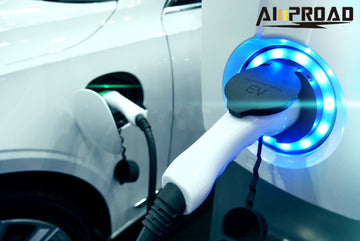
As society progresses and environmental consciousness grows, an increasing number of consumers are embracing electric vehicles (EVs) as an alternative to traditional fuel-powered vehicles. This shift has created a surging demand for electric vehicle charging equipment, prompting many to seek information on topics such as "EV chargers near me," "EV charger costs," "EV charger maps," and "EV charger types." In this comprehensive introduction, we will explore the landscape of electric vehicle charging equipment in the United States, shedding light on its current state, features, and distribution.
EV Charger Quantity and Infrastructure Development
The United States has made significant strides in expanding its electric vehicle charging infrastructure, but there is still room for growth. According to the Alternative Fuels Data Center (AFDC), as of early May 2023, there were approximately 138,000 public EV chargers across the country, with around 106,000 being AC chargers and 31,000 being DC fast chargers. However, the ratio of vehicles to chargers remains high at 26.6:1, indicating a need for further infrastructure development.
To address this gap, the United States' Infrastructure Act of 2021 allocated $7.5 billion to support the installation of EV chargers and build a network of approximately 500,000 charging stations along federal highways. This initiative aims to facilitate the widespread adoption of electric vehicles by providing a comprehensive and accessible charging network.
Furthermore, the United States has implemented regulations to promote domestic manufacturing of EV charging equipment. Starting in July 2024, any home Level 2 EV charger or public charger receiving federal funding must be produced in the United States, with at least 55% of the components being domestically sourced. This measure aims to strengthen the local supply chain and support the growth of the EV charging industry within the country.
EV Charger Features and Advancements
The electric vehicle charging equipment in the United States is continuously evolving, incorporating newer and more advanced features. One notable trend is the increasing prevalence of ultra-high-power charging facilities. Starting in 2022, the proportion of these high-powered chargers has significantly increased, with more than half of the fast EV chargers exceeding 250 kW. This development caters to the growing demand for faster charging times, aligning with the rapid advancement of EV technology.
In the realm of DC fast charging networks, Tesla's Supercharger network accounts for a dominant 60.3% share, followed by Electrify America at 12.7% and EVgo at 8.4%. These networks are primarily composed of DC fast chargers, catering to the need for rapid charging capabilities.
Among the various charging networks in the United States, ChargePoint boasts the largest number of public EVCS, accounting for 40.6% of the total. However, the majority of these chargers are AC chargers. Other prominent players, such as the new generation of operators like Electrify America, EVgo, Francis Energy, FPL EVolution, Rivian Adventure Network, and Tesla Supercharger, primarily offer DC fast charging stations.
Distribution and Accessibility of EV Chargers

The distribution of public EV chargers in the United States is notably uneven, with affluent states and communities having better access to charging infrastructure. States with higher per capita incomes tend to have more EV chargers per 10,000 people. For instance, Nevada, Colorado, Washington, D.C., Florida, and California have the highest number of chargers per capita.
In contrast, the five lowest-income states (Mississippi, Arkansas, Kentucky, Alabama, and Louisiana) have fewer than two EV chargers per 10,000 people, well below the national average of 2.4 chargers per 10,000 people. Additionally, 60% of the lowest-income counties in the United States do not have any EV chargers.
Disparities in access to charging infrastructure also exist along racial lines. White communities have an average of 3.03 EV chargers per 10,000 people, which is twice the number in Black or African American counties and nearly 2.7 times more than in majority Indian and Alaska Native counties.
Addressing the Challenges and Fostering Growth
The development of EV charging equipment in the United States faces several challenges, including the need to balance market demand with the growth of local manufacturing capabilities. Finding the right equilibrium between expanding the charging infrastructure and developing a robust domestic supply chain is crucial for long-term sustainability.
To overcome these hurdles, mainstream institutions in the United States generally recognize the importance of investing in charging infrastructure as a key enabler for the widespread adoption of electric vehicles. Initiatives such as the Infrastructure Act and domestic manufacturing regulations aim to address these challenges and foster a thriving EV charging ecosystem.
Innovations and Emerging Trends
As the EV market continues to evolve, innovative solutions and emerging trends are shaping the future of electric vehicle charging equipment. One notable development is the introduction of the fastest home EV charger, which promises lightning-fast charging times for residential EV owners. Manufacturers like the Canadian-based EV charger manufacturer AMPROAD are at the forefront of this innovation, offering cutting-edge home charging solutions that cater to the growing demand for convenience and efficiency.
Another significant trend is the expansion of the Tesla destination charger network, which aims to provide charging solutions at popular destinations such as hotels, restaurants, and shopping centers. This initiative not only enhances the charging experience for Tesla owners but also contributes to the overall growth of the EV charging infrastructure.
Furthermore, Level 2 EV chargers are gaining popularity as a reliable and cost-effective option for residential and commercial charging needs. These chargers offer faster charging times compared to standard Level 1 chargers, making them a practical choice for EV owners who require more frequent charging or have shorter dwell times.
As the electric vehicle market continues to gain momentum, the demand for efficient, reliable, and accessible charging equipment will only increase. The United States' commitment to expanding its charging infrastructure, coupled with the innovations and advancements from leading manufacturers like AMPROAD, promises a future where EVs become a mainstream and sustainable mode of transportation.
The introduction of electric vehicle charging equipment in the United States is a complex and dynamic landscape, with challenges and opportunities coexisting. While significant progress has been made in terms of infrastructure development and technological advancements, efforts must continue to address issues of accessibility, equity, and domestic manufacturing capabilities. By fostering collaboration between policymakers, industry leaders, and innovative manufacturers, the United States can pave the way for a seamless transition to a more sustainable and electric-powered future.


